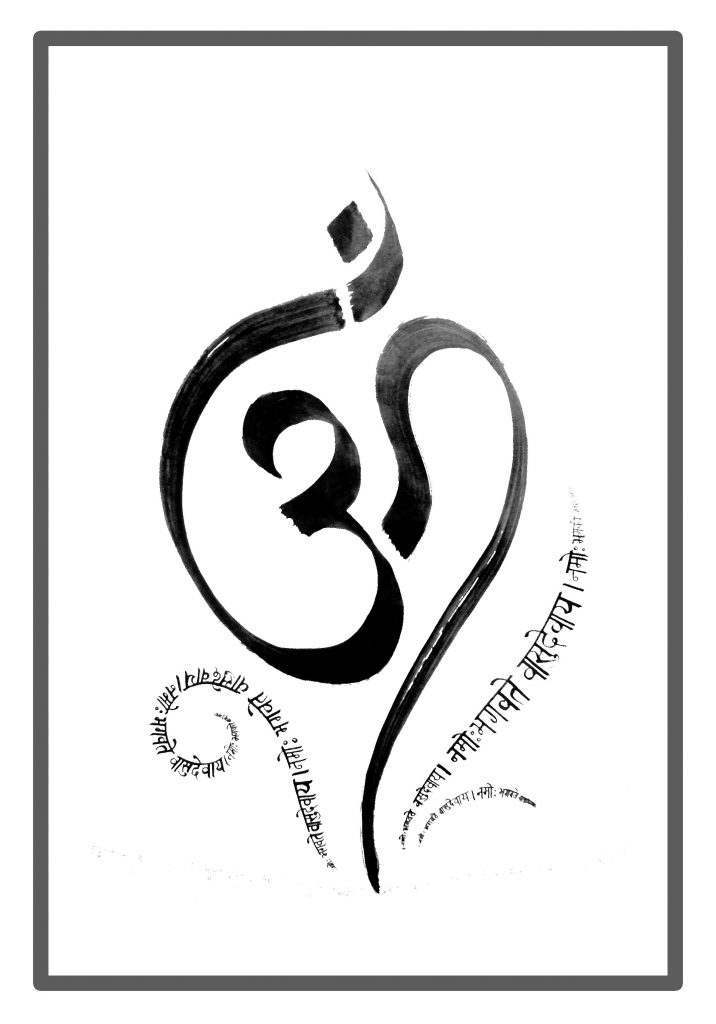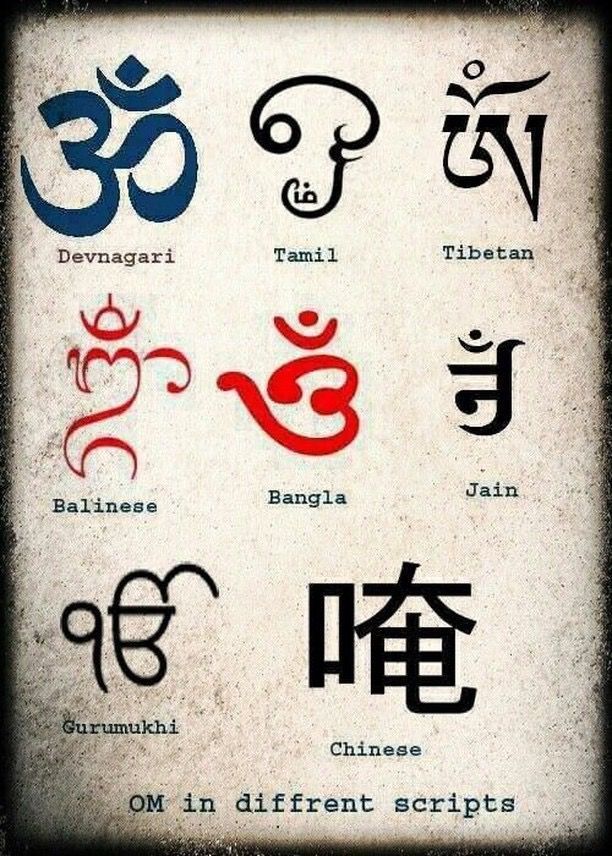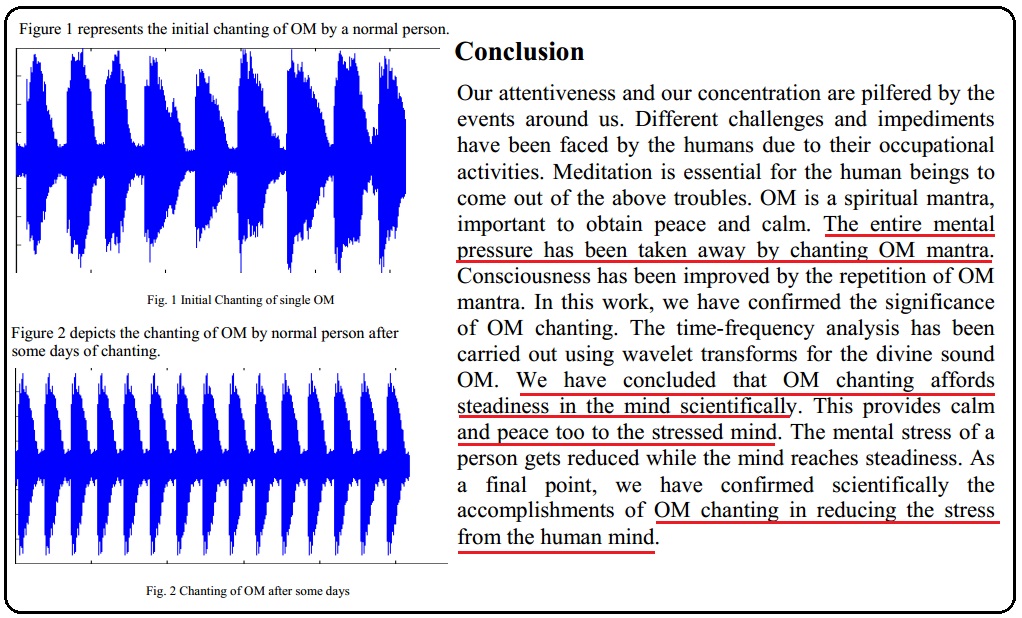Exercise 13
Mantra Japa
Difficulty level – 2 (moderately difficult)
Time commitment : 10 minutes thrice a week

We have, so far, practiced an āsana, a form of prānāyāma, a mudra and basic meditation. Bringing this all together is mantra japa, or meditative repetition of a mantra.
The mantra that I have chosen is Aum, since it is familiar (but a bit different from what you may have heard), and it does not require any elaborate initiation methods.
A few points to note:
- Approach- Mantras are considered to be persons, who are on a higher dimension than us. Hence, one should approach mantra japa with devotion and respect, in order to imbibe the full essence and benefits of the mantra. Ensure that you have only vegetarian food on the day that you practice mantra japa. Also, have a shower before practice.
- Time and place – Mantra japa should be practiced before sunrise or just after sunset, and on an empty stomach (at least 3 hours after a light meal). Choose a quiet, well-ventilated place inside your house. Do not switch on the air conditioning – if you feel hot, a fan should suffice. Perform the japa at the same place and the same time everyday.
- Prayer beads – I do not recommend prayer beads for beginners. Using these beads requires proper initiation from a Guru, and a proper procedure of activating the energies associated with these beads. Using them incorrectly can be detrimental.
- Yoga mat – Not required for mantra japa. A rug would suffice. Not too soft though.
How you do it
Preparatory
ॐ is pronounced in two ways – Om, and Aum. The correct pronunciation for mantra japa is AUM. Take a couple of minutes to listen to the audio file at the end of this post to familiarise yourself with the correct pronunciation.
There is a proportion to the components of AUM as well – A:U:M is 1:1:2, i.e, if A is 2 seconds, U is 2 seconds and M is 4 seconds.
Also, try pronouncing it s few times, with your eyes closed. Move the palm of your hand as indicated below:
During the “A” sound, feel your chest area with your palm, move it to your throat area during the “U” sound and the top of your head during the “M” sound. If you feel the vibrations in these corresponding areas, you are pronouncing it correctly.
A common mistake is making shallow sounds from just the throat area, and this should be avoided.

Mantra Japa
- Sit in a comfortable position. Ideally in Sukhasana or Vajrasana. Avoid sitting on a chair. Keep your back straight. If you find this difficult, try the Vajrasana posture since the back is naturally straight in this āsana. Your hands can be kept loosely on your thighs, palms facing down, or if you know how to do it, in jnana mudra. Close your eyes. Breathe normally.
- Turn your eyes slightly downward and close them gently. During mantra japa your eyes may move upward and downward naturally – don’t try to control this movement.
- Be aware of your natural breath flowing in and out. Breathe through your nose, keep your jaw muscles relaxed, so that your teeth are not clenched or tensed.
- Take a couple of minutes of deep, slow breathing to slow down your breath, and feel a sense of calm.
- Now start the japa. Feel the vibration of each component of the AUM mantra, and focus on the area between your eyebrows (Agya Chakra). Move your attention to the corresponding area of vibration, as the mantra progresses from the lower chest, to the throat, and finally, to the head.
- For beginners – 16 times is ideal. You can progress in the following sequence – 8 times in weeks 1 and 2, and 16 times in week 3.
- If counting mentally is tough, or disturbs your concentration or intonation, then do the math – you ideally do 4 japas a minute, so set your timer to four minutes for a 16-japa session.
- Once done with the number of tapas, continue to sit in the same āsana, with your eyes closed, and feel the silence for an equal number of minutes. For example, if your japa took 4 minutes, meditate in silence for an additional 4 minutes.
- Bring your hands together in anjali mudra, say a small prayer, and gently open your eyes.
Breathing
Gentle breathing, without strain or effort. Take in deep slow inhalations, with an expanded chest, and deep slow exhalations as you continue with the japa, with your stomach moving towards your spine. Don’t try to prolong the japa (and the corresponding exhalation) in the beginning – let it flow with your natural breath. The emphasis is on the pronunciation and awareness, not on the length of the japa.
Awareness
Maintain awareness on the vibrations felt in the body during the AUM japa.
Notice the energy traveling from your chest to your head, and also feel the more pronounced vibrations felt when making the “mmmmmmmmmmmm” sound. This sound is a meditation in itself.
Also be aware of the space in between your eyebrows – in advanced stages of practice, you can roll your eyes upwards and inwards to “see” this space from the inside. At the beginning though, just be aware of this, and feel the slight tingling sensation here, as you do the japa.
Benefits
Physical – greatly improves the capacity of your lungs, and can be counted as a full prānāyāma exercise. The full cycle of inhalation and exhalation, combined with the AUM sound during exhalation, helps improve lung performance with time. AUM chanting helps improve blood circulation, thus flushing out toxins and aids in digestion, due to the relaxation of the digestive system during the japa. The vibrations felt during the japa, help stimulate metabolism and the thyroid gland.
Mental and Spiritual
AUM japa has been proven to reduce stress and anxiety (see the evidences at the end of this post). It improves concentration and removes negativity to a large extent. The spiritual benefits of AUM japa are too many to be adequately covered in this post, For now, let it suffice to say that the regular chanting of AUM helps us discover our true selves, and connect with the infinite cosmic consciousness.

मननत् त्रायते इति मंत्र:
Mananat trayate iti mantrahIt means that by repetition (mananat) of which, you overcome or are protected from troubles/cycle of births and deaths (trayate), it is (iti) called Mantra.
man is contemplation and tra is liberation – mantra brings liberation through reflection, and the same happens when one reflects on the sound of the breath.
Pundit Vamadeva Shastri (David Frawley) has written an excellent book on Mantra Yoga, and it’s subtleties. He speaks about the energies of a mantra, that depend on three factors:
Sound – The effect of the mantra relates to the nature of it’s sound, in it’s different vowels and consonants and the particularities of it’s pronunciation. Each sound has a certain quality that reflects the potential meaning that it can serve as a vehicle for. This is the ‘body‘ of the mantra.
Pranic Factor – This effect of the mantra depends on how the sound is made. The same sound can be made with more or less force, intensity, velocity or Prana, which will naturally alter it’s energy, meaning and impact. This is how the mantra is aligned with the breath, and is the ‘Prana‘ or ‘life-force’ of the mantra.
Mental Factor – This effect of the mantra depends upon how we energise it with thought, meaning, intention and emotion. This is the ‘mind and heart‘ of the mantra.
For example, take the AUM mantra. The sound factor relates to the (correct) pronunciation of “A”, “U”, and “M”, and in the correct ratio, without which, this just becomes a collection of mixed sounds. The panic factor takes into consideration the energy of the vibrations felt in the different parts of the body when reciting AUM. The mental factor, that is most important, takes into consideration your focus on intention and the surrender to the meaning of the AUM mantra.
A lot of yoga trainers take mantra japa classes, without taking these factors into consideration. A mantra pronounced incorrectly is not a mantra – it remains a sound that is unable to manifest anything useful. Yes, you may still get some lung exercise, but you didn’t come for just that, did you?
तस्य वाचकः प्रणवः
tasya vācakaḥ praṇavaḥ
Patanjali Yoga Sutras
The word for HIS being is OM.
पिताहमस्य जगतो माता धाता पितामह: ।
वेद्यं पवित्रम् ॐकार ऋक् साम यजुरेव च ॥ १७ ॥
pitāham asya jagato
mātā dhātā pitāmahaḥ
vedyaṁ pavitram oṁ-kāra
ṛk sāma yajur eva ca
Bhagavad Gīta 9.17
I am the father of this universe, the mother, the support and the grandsire. I am the object of knowledge, the purifier and the syllable Oṁ. I am also the Ṛg, the Sāma and the Yajur Vedas.
ॐ मणिपद्मे हूँ
ཨོཾ་མ་ཎི་པདྨེ་ཧཱུྃ
Auṃ maṇi padme hūṃ
in Mahayana Buddhism
ੴ, ਇੱਕ ਓਅੰਕਾਰ
Ik Onkar
Sikhism




Pingback: Seeking peace – Shihan Rohit Ghai